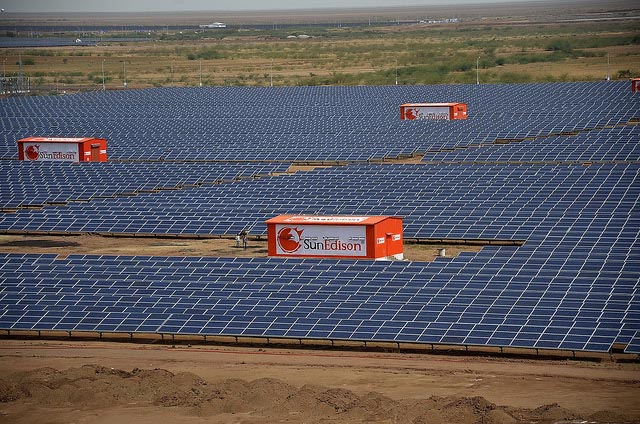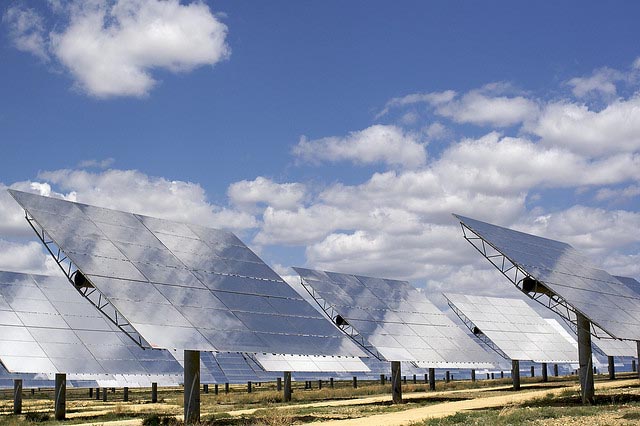Utility-scale solar power covers a lot of ground, in terms of size of installation (from tens of megawatts to hundreds, and even plans, yet to be realized, for gigawatt-sized power plants), and in terms of technology (there’s a world of difference between photovoltaics and concentrating solar power). But no matter how you choose to look at it, 2012 was a pretty stellar year.
For the first time, global solar power passed the 100 GW mark, with 30 GW added last year alone. Perspective on that growth: In 2010, global solar power capacity was nearly 40 GW. So, in just the past two years solar power has more than doubled.

More detail about those installations, on both the international level and in the United States, in a bit. But first, so that everyone’s on the same page in terms of the technology, let’s talk about the different ways to produce electricity from the sun.
Solar Power in Acronyms: PV versus CSP versus CPV
The majority of solar power installed uses photovoltaics. This is what most people think of when you talk about solar power, solar panels. Without getting too technical, a solar panel consists of multiple solar cells made of photovoltaic material, converting solar radiation into direct current electricity.
Silicon is the most common material used for solar cells, but other materials can also be used. Over the past three years, the price of silicon has dropped precipitously, with prices per kilogram now sitting under $20, as of the end of 2012.
Photovoltaics have a major advantage: They are easily scalable, modular — meaning that they can expand from a couple kilowatts, to megawatts, all the way to hundreds of megawatts.
The other solar power technology is concentrating (or concentrated) solar power — sometimes these are called solar thermal power plants. Here some sort of mirror system focuses sunlight onto either a central tower or decentralized tubes containing a liquid. That liquid becomes heated, turning to steam, which then turns a turbine.
It’s the same basic principle that a coal, a natural gas, or even a nuclear power plant operates on: Steam is generated, a turbine turns, creating electricity. But in concentrating solar power plants, the heat creating the steam comes from the limitless power supply of the sun. There are several different set-ups for doing this: The aforementioned mirrors focusing the sun onto a central tower (that’s the photo on the next page), parabolic mirrors focusing the sun onto a trough, fresnel reflectors, dish sterling systems.
It’s often this technology that powers the world’s largest solar installations, from the 354 MW Solar Energy Generating System in California (which consists of nine separate power plants), to the current record holder for largest single plant, a 100 MW installation in Abu Dhabi. There are a number of larger plants proposed though, including a 500 MW one in California that’s expected to come online in 2016.
Over the past several years plans have been proposed that go even beyond that size, but are as yet never completed, for concentrating solar power plants above 1 gigawatt — their failure to materialize has had more to do with financing than the technology though.
Though these are the main two solar power technologies, there is a third, as yet comparatively untapped: Concentrating photovoltaics. Here, some sort of optical system concentrates the sunlight onto a solar cell, increasing the amount of power that can be generated in a given area of panel. To date though, the added cost of such a system has made them less common that either regular solar PV or concentrating solar power plants.

Massive Growth, Even Bigger Potential
It’s taken as a green energy article of faith that way more sunlight falls on the planet’s surface each day than we need — solar power has the theoretical potential to generate something like 6000 times the amount of power than we currently use.
Obviously that’s a theoretical potential, as there’s only so much land that can actually be allocated to solar power generation, but it gives you a very clear idea that, perhaps more than any other renewable energy technology, solar power has the greatest practical potential.
Solar power is still a tiny fraction of the world’s power supply, but it’s growing remarkably. Let’s take a look at what’s happened in the past year.
The Solar Energy Industries Association has just released new data on installations in 2012 for the United States. Last year saw 76% growth in the US market, with an addition of slightly over 3.3 GW of new solar power capacity—about half of that was utility-scale, about one quarter non-residential commercial installation, and the remainder was residential. Prices for photovoltaic systems dropped 27% over the previous year.
In terms of utility-scale installations, 874 MW was installed in the fourth quarter of the year alone, the single-largest quarterly installation on record.
At the state level, California is still the US leader in solar power, with 1032 MW of solar PV installed last year. Arizona comes in second (710 MW), New Jersey third (415 MW), Nevada fourth (198 MW), and North Carolina fifth (132 MW).
All of these new installations mean that the United States now has 7.7 GW of solar power capacity, ranking it fourth in the world.
I won’t break down every other nation by state or region, but here’s how the global rankings stand as of the end of last year:
Germany leads the way with 32.5 GW of solar power (driven by it’s world-leading policy support for the technology); Italy is in second place with roughly 17 GW installed; China is in third place at slightly over 8 GW in capacity. Following the United States, Japan is in fifth place, with Spain, France, Belgium, the Czech Republic, and Australia rounding out the top ten places.
Worthwhile noting, India currently occupies the 11th place for solar power installations, with 1.43 GW in total — over triple the capacity it had at the end of 2011. The nation aims for over 20 GW of capacity over the next decade. At current rates of growth, India will likely hit that target — that is, if trade wars don’t get in the way.
More Solar Power is Good, No Matter Where It’s Installed or Made
You see, part of India’s plan for domestic solar power growth, includes provisions that a certain amount of solar power products also come from domestic manufacturers — which has recently aroused the ire of the United States, precipitating a complaint with the WTO than such provisions violate free-trade laws. India denies that they are in violation of any regulation.
For different reasons, this time over allegedly unfair subsidies for domestic industry, the United States has also tried to find fault with China’s efforts to expand its domestic solar power industry — enacting tariffs to attempt to offset what it sees as handicaps for US manufacturers competing against their Chinese brethren.
Without going into the merits of either the US, Chinese or Indian positions in these cases, from the global perspective (which is frankly the most important one when it comes to rapid deployment of renewable energy to combat climate change), the more solar power installed around the world the better — which nation’s industry flourishes because of it really does not matter one bit, in any perspective but the most narrowly nationalistic.